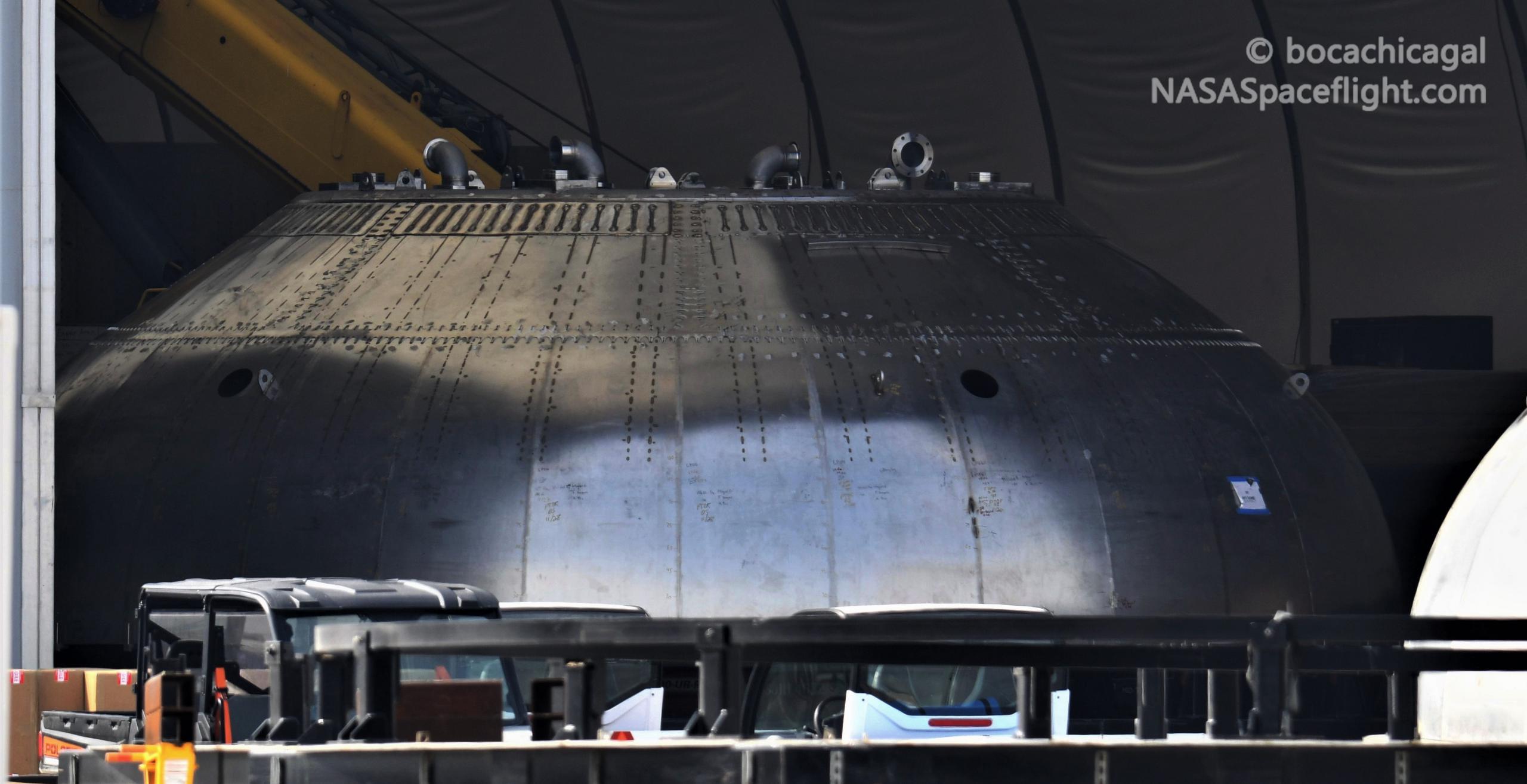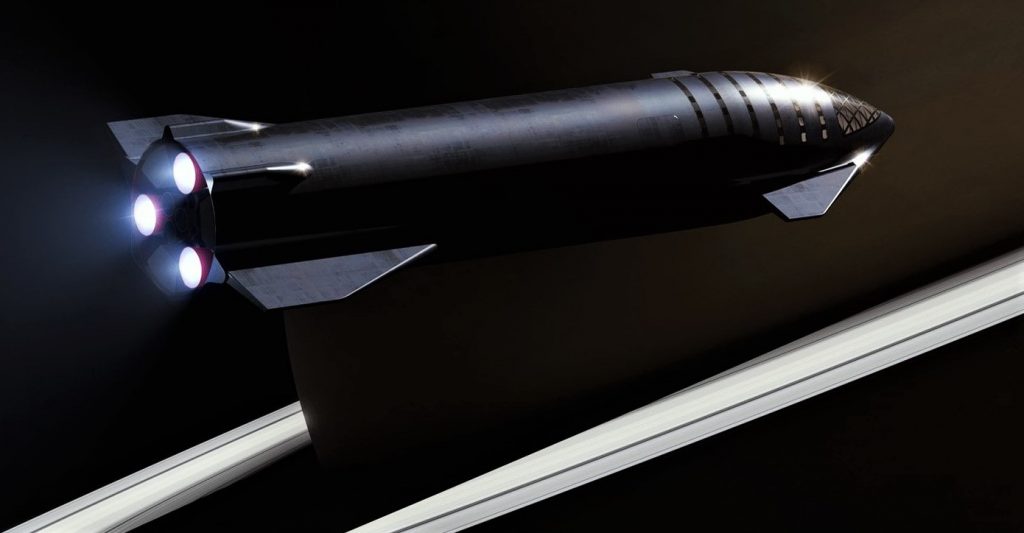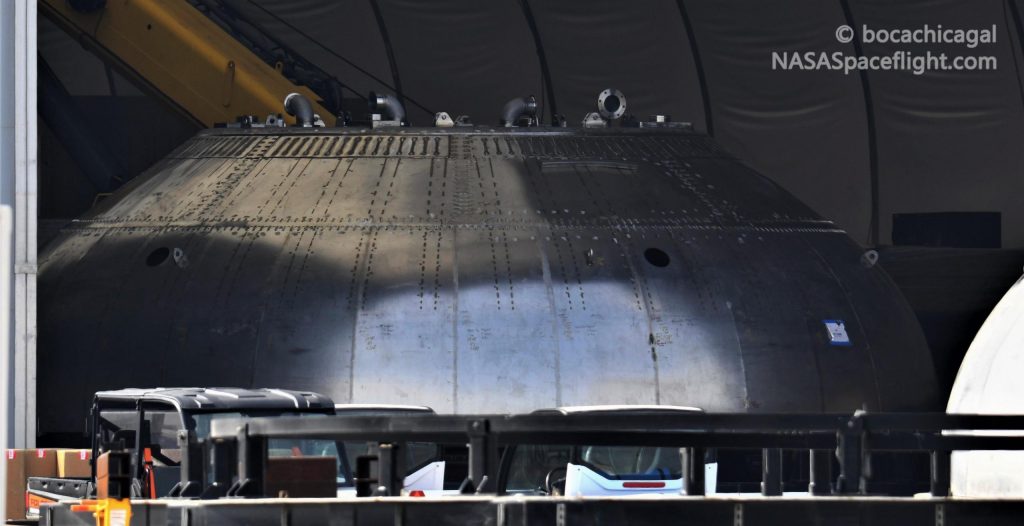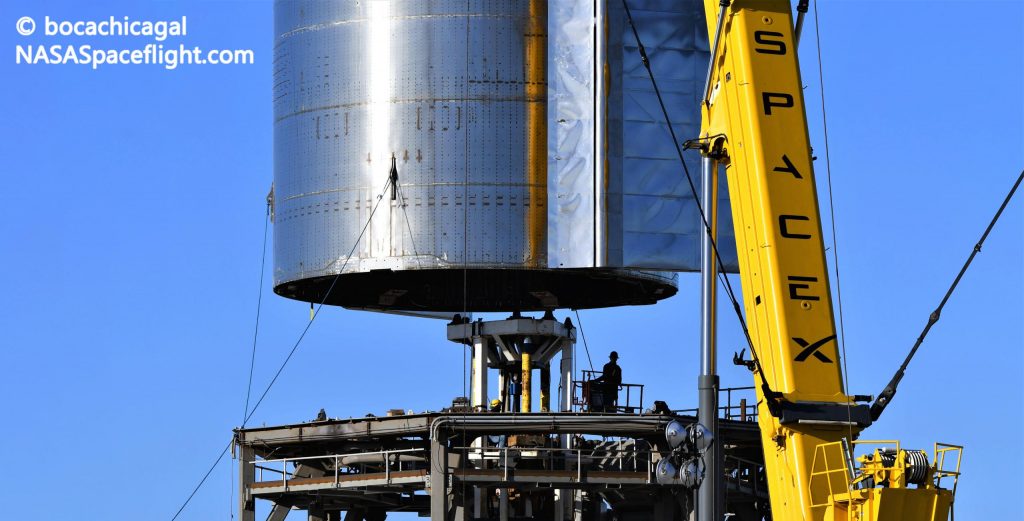

News
SpaceX’s most important Super Heavy booster part makes first appearance
What is arguably the most complex and important part of SpaceX’s Super Heavy booster prototype has made its first appearance at the company’s South Texas Starship factory.
Following in the footsteps of Starship development, Super Heavy has been able to extensively borrow from the many lessons learned over the course of building, testing, flying, and building more Starship prototypes. SpaceX is able to use virtually identical materials, equipment, and techniques to build and assemble both Starship and Super Heavy propellant tank barrels and domes, while both stages will also share an extensive foundation of avionics, plumbing, propulsion, and ground systems, among other things.
In fact, lacking a conical nose, secondary (‘header’) propellant tanks, flaps, a reusable orbital-class heatshield, and vacuum-optimized Raptor engines, Super Heavy is actually substantially simpler than the Starships it will one day launch towards orbit. However, not everything is simpler. Super Heavy will ultimately be the largest and most powerful liquid-fueled rocket stage ever built or tested – power that demands as many as 28 Raptor engines and a thrust structure capable of feeding and withstanding them.
Designing, building, and testing such a thrust structure is arguably one of – if not the – most challenging engineering hurdle standing between SpaceX and its aspirational Super Heavy design. It’s the first of those Super Heavy-specific thrust structures – in the form of a tank dome – that was spotted at SpaceX’s Boca Chica, Texas Starship factory on January 25th, roughly six weeks after its main component was spotted.
Unlike Starship, which relies on a small central ‘thrust puck’ fit for three sea-level-optimized Raptor engines and plans for three larger vacuum-optimized engines that will attach to the side of its hull, Super Heavy’s current design iteration features as many as 28 sea-level Raptors. Aside from CEO Elon Musk revealing that Super Heavy would have a central cluster of eight engines, the precise configuration has been a mystery.

The reality, as recently captured in photos above by NASASpaceflight photographers and contributors Mary (BocaChicaGal) and Jack Beyer, appears to be a much larger donut-shaped ring with space for eight gimballing Raptor engines. The remaining 20 Raptor engines would then be installed – possible mounted to the skirt, the thrust dome, or both – in the space left between the thrust donut and Super Heavy’s skirt.
Either way, the structures behind the two rings of engines will have to withstand at least 6600 metric tons (14.5 million lbf) of thrust at liftoff – approximately twice the thrust of Saturn V and Soviet N-1 rockets and more than three times the thrust of SpaceX’s own Falcon Heavy. Holding eight Raptors, the donut structure and dome recently pictured for the first time will also have to singlehandedly stand up to 1600 tons (3.5 million lbf; two Falcon 9s’ worth) of thrust while gravity, acceleration, and some 2500 tons of supercooled liquid oxygen push in the opposite direction.



In simpler terms, the business end of Super Heavy poses an extraordinarily difficult challenge and SpaceX has already built the first true-to-life prototype, with future iterations likely close on its heels. Much like Starship, if/when prototype booster number one (BN1) passes basic pressure and cryogenic proof tests, SpaceX will likely focus the rest of Super Heavy’s first test campaign on stressing the rocket’s unproven thrust structure to its design limits.
Like Starship, SpaceX will likely try to begin with nonexplosive methods, perhaps using a similar – but far larger – series of hydraulic rams to less riskily simulate the thrust of 8-28 Raptor engines. A steel structure spotted on a recent aerial overflight of SpaceX’s Starship factory might even fit the bill for such a structure, though only time will tell.
Based on an apparent acceleration of Super Heavy assembly work that may have started last week, as well as the crucial appearance of the last missing puzzle piece in the form of BN1’s thrust dome, the first booster could be completed and ready for testing sooner than later.

News
Nvidia CEO Jensen Huang explains difference between Tesla FSD and Alpamayo
“Tesla’s FSD stack is completely world-class,” the Nvidia CEO said.

NVIDIA CEO Jensen Huang has offered high praise for Tesla’s Full Self-Driving (FSD) system during a Q&A at CES 2026, calling it “world-class” and “state-of-the-art” in design, training, and performance.
More importantly, he also shared some insights about the key differences between FSD and Nvidia’s recently announced Alpamayo system.
Jensen Huang’s praise for Tesla FSD
Nvidia made headlines at CES following its announcement of Alpamayo, which uses artificial intelligence to accelerate the development of autonomous driving solutions. Due to its focus on AI, many started speculating that Alpamayo would be a direct rival to FSD. This was somewhat addressed by Elon Musk, who predicted that “they will find that it’s easy to get to 99% and then super hard to solve the long tail of the distribution.”
During his Q&A, Nvidia CEO Jensen Huang was asked about the difference between FSD and Alpamayo. His response was extensive:
“Tesla’s FSD stack is completely world-class. They’ve been working on it for quite some time. It’s world-class not only in the number of miles it’s accumulated, but in the way it’s designed, the way they do training, data collection, curation, synthetic data generation, and all of their simulation technologies.
“Of course, the latest generation is end-to-end Full Self-Driving—meaning it’s one large model trained end to end. And so… Elon’s AD system is, in every way, 100% state-of-the-art. I’m really quite impressed by the technology. I have it, and I drive it in our house, and it works incredibly well,” the Nvidia CEO said.
Nvidia’s platform approach vs Tesla’s integration
Huang also stated that Nvidia’s Alpamayo system was built around a fundamentally different philosophy from Tesla’s. Rather than developing self-driving cars itself, Nvidia supplies the full autonomous technology stack for other companies to use.
“Nvidia doesn’t build self-driving cars. We build the full stack so others can,” Huang said, explaining that Nvidia provides separate systems for training, simulation, and in-vehicle computing, all supported by shared software.
He added that customers can adopt as much or as little of the platform as they need, noting that Nvidia works across the industry, including with Tesla on training systems and companies like Waymo, XPeng, and Nuro on vehicle computing.
“So our system is really quite pervasive because we’re a technology platform provider. That’s the primary difference. There’s no question in our mind that, of the billion cars on the road today, in another 10 years’ time, hundreds of millions of them will have great autonomous capability. This is likely one of the largest, fastest-growing technology industries over the next decade.”
He also emphasized Nvidia’s open approach, saying the company open-sources its models and helps partners train their own systems. “We’re not a self-driving car company. We’re enabling the autonomous industry,” Huang said.
Elon Musk
Elon Musk confirms xAI’s purchase of five 380 MW natural gas turbines
The deal, which was confirmed by Musk on X, highlights xAI’s effort to aggressively scale its operations.

xAI, Elon Musk’s artificial intelligence startup, has purchased five additional 380 MW natural gas turbines from South Korea’s Doosan Enerbility to power its growing supercomputer clusters.
The deal, which was confirmed by Musk on X, highlights xAI’s effort to aggressively scale its operations.
xAI’s turbine deal details
News of xAI’s new turbines was shared on social media platform X, with user @SemiAnalysis_ stating that the turbines were produced by South Korea’s Doosan Enerbility. As noted in an Asian Business Daily report, Doosan Enerbility announced last October that it signed a contract to supply two 380 MW gas turbines for a major U.S. tech company. Doosan later noted in December that it secured an order for three more 380 MW gas turbines.
As per the X user, the gas turbines would power an additional 600,000+ GB200 NVL72 equivalent size cluster. This should make xAI’s facilities among the largest in the world. In a reply, Elon Musk confirmed that xAI did purchase the turbines. “True,” Musk wrote in a post on X.
xAI’s ambitions
Recent reports have indicated that xAI closed an upsized $20 billion Series E funding round, exceeding the initial $15 billion target to fuel rapid infrastructure scaling and AI product development. The funding, as per the AI startup, “will accelerate our world-leading infrastructure buildout, enable the rapid development and deployment of transformative AI products.”
The company also teased the rollout of its upcoming frontier AI model. “Looking ahead, Grok 5 is currently in training, and we are focused on launching innovative new consumer and enterprise products that harness the power of Grok, Colossus, and 𝕏 to transform how we live, work, and play,” xAI wrote in a post on its website.
Elon Musk
Elon Musk’s xAI closes upsized $20B Series E funding round
xAI announced the investment round in a post on its official website.

xAI has closed an upsized $20 billion Series E funding round, exceeding the initial $15 billion target to fuel rapid infrastructure scaling and AI product development.
xAI announced the investment round in a post on its official website.
A $20 billion Series E round
As noted by the artificial intelligence startup in its post, the Series E funding round attracted a diverse group of investors, including Valor Equity Partners, Stepstone Group, Fidelity Management & Research Company, Qatar Investment Authority, MGX, and Baron Capital Group, among others.
Strategic partners NVIDIA and Cisco Investments also continued support for building the world’s largest GPU clusters.
As xAI stated, “This financing will accelerate our world-leading infrastructure buildout, enable the rapid development and deployment of transformative AI products reaching billions of users, and fuel groundbreaking research advancing xAI’s core mission: Understanding the Universe.”
xAI’s core mission
Th Series E funding builds on xAI’s previous rounds, powering Grok advancements and massive compute expansions like the Memphis supercluster. The upsized demand reflects growing recognition of xAI’s potential in frontier AI.
xAI also highlighted several of its breakthroughs in 2025, from the buildout of Colossus I and II, which ended with over 1 million H100 GPU equivalents, and the rollout of the Grok 4 Series, Grok Voice, and Grok Imagine, among others. The company also confirmed that work is already underway to train the flagship large language model’s next iteration, Grok 5.
“Looking ahead, Grok 5 is currently in training, and we are focused on launching innovative new consumer and enterprise products that harness the power of Grok, Colossus, and 𝕏 to transform how we live, work, and play,” xAI wrote.








